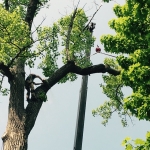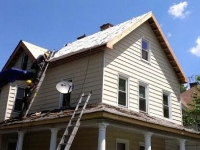South Orange Reservation Mask wearing
I think we all agree that Trump has done a horrible job.
But how are the governors of the two states that were hit the worst are getting all the credit?
NJ has 11% of the COVID-19 deaths in the U.S. Do people think there was nothing else Murphy could have done to lessen this number? California has 4x the population of New Jersey but only 1/3 of the deaths. What did California do differently than NJ or NY? Or is NJ just unlucky and CA is really lucky?
New Jersey's first case was on March 4th. Murphy declared state of emergency on March 9th. On March 15th Murphy announced a statewide shutdown is imminent but doesn't declare statewide shutdown until March 21st. The number of cases in NJ went from 98 (two deaths) on the 15th to 1,327 (16 deaths) on the 21st. People were already dying. What was Murphy waiting for?
Our school district closed on March 13th. Murphy gave NJ school districts until the 18th to close.
I have been listening to the televised daily briefings by the Governors of both New York and New Jersey. I keep hearing both of them emphasizing baby steps with facial coverings and social distancing being a given in each step they take towards re-opening. From what I can see too many people are interpreting the start of the reopening process as an invitation to have large gatherings, cease practicing social distancing, and no longer wear facial coverings when social distancing can no longer be practiced. This is not the message either governor is sending.
joan_crystal said:
I have been listening to the televised daily briefings by the Governors of both New York and New Jersey. I keep hearing both of them emphasizing baby steps with facial coverings and social distancing being a given in each step they take towards re-opening. From what I can see too many people are interpreting the start of the reopening process as an invitation to have large gatherings, cease practicing social distancing, and no longer wear facial coverings when social distancing can no longer be practiced. This is not the message either governor is sending.
Just before Memorial Day Weekend, Murphy announced outdoor gatherings of up to 25 people were allowed. Today he announced schools can have graduation ceremonies in July. Yes, he said social distancing was still required but the main message people are hearing is they can gather in large groups now. Maybe the messaging needs to be more effective.
“What did California do differently than NJ or NY? Or is NJ just unlucky and CA is really lucky?”
Population density combined with high use of public transit worked against NJ and NY compared with CA.
berkeley said:
“What did California do differently than NJ or NY? Or is NJ just unlucky and CA is really lucky?”
Population density combined with high use of public transit worked against NJ and NY compared with CA.
San Fran is one of most densely populated cities in America with extensive public transit. How did they avoid the same fate at NY/NJ?
Murphy and Cuomo failed miserably when it came to long-term care/nursing facilities.
"More than 40% of the coronavirus deaths in the state have been tied to long-term care settings — a staggering toll that includes the elderly, decorated soldiers, patients with dementia. Based on the state’s own numbers, that means roughly 1 in 13 people who were in long-term care when the pandemic started in New Jersey are now dead — 5,368 to date. Scores of nursing home employees died as well.
Gov. Phil Murphy’s administration largely has blamed nursing home owners."
(Refers to comment about Cal response, not nursing homes): I'm not saying that Murphy/Cuomo have done everything right, but checking population density shows that San Fran is a lot lower than NY and many areas of NJ. Cable cars are at least partially open air, which I imagine also helps. To his credit, Cal's governor has had one of the most aggressive covid containment policies, which in part is probably related to the fact the initial US cases were detected on the West Coast.
It is my opinion that poor federal leadership ("it's not a problem here") and the CDC testing debacle are the main reasons for the less than optimal response in the badly impacted areas. Of course there couldn't be any cases here (!!??) since there was no/minimal testing for cases in February. Not to mention Murphy was dealing with his own personal health crisis as this was developing.
No doubt the whole situation is terrible.
https://en.wikipedia.org/wiki/List_of_United_States_cities_by_population_density
Cable cars in San Fran are a tourist attraction. They have extensive bus, light rail, ferry, and commuter rail system. The only difference from NY/NJ is they don't have a subway.
San Fran is among the richest places in the country per capita. The silicon Valley effect has pushed out the poor, working class and modest middle class in droves. They just may have a lot less of the vulnerable populations that got hit so hard here.
Also, the end is flights from Italy and elsewhere in Europe was particularly poorly managed. Do you remember the images of the crowded airports? I don’t thing the volume of inbound passengers from Wuhan was nearly as large, so this difference may have also made the east coast problem worse.
Mayor of San Francisco was on NPR, said despite his area’s mass transit, the vast majority of workers get to their jobs alone in cars, and he thinks that’s what made the difference. He also noted a lot of people at jobs in Silicon Valley work in individual offices/cubicles and that that also halted a lot of transmission.
On the subject of uncrowded green space options, we went to the NJ Botanical Gardens in Ringwood State Park yesterday. Lovely and not crowded at all. Free during the week (not sure how they collect parking fee on the weekend).
I’d love to take the the kids somewhere outdoors, but with their ages bathrooms would be a problem, so we’re foregoing it for now.
To clarify, not finding bathrooms isn’t what I’m worried about. It’s that bathrooms are interior spaces used by lots of people, so the risks are higher there. Even if we use ours before leaving the house, the five and seven year old would probably need one while out
We brought a kids potty-on-the-go with us (in an easy travel bag) when we didn't know if bathrooms would be available. Looks like it's discontinued though.
Back to mask wearing...I have to say it is surprising to not see more masks on my frequent neighborhood dog walks. I keep a mask pulled off my face until I pass other people. Normal 30 min walk means about 2 min with a mask on. It really isn’t a hassle. This morning I passed probably 20 people and not one had a mask.
I realize it isn’t mandatory but if you have one wouldn’t it be nice to protect your neighbors just in case?
Correction to what I had posted and now deleted:
The WHO is now saying a mask is only necessary if caring for someone who is sick.
I believe it is the New England Journal of Medicine that had something saying masks were only needed in a healthcare setting.
I’ll still wear masks in stores, at the gas station, and at the drive through because it isn’t just about catching it, but also transmitting it if you are an asymptomatic cattier. I’m just wondering what information these newest recommendations are based on
I carry a mask and put it on when I see someone coming. Most of the time I have the block to myself so social distancing isn't much of a problem. This morning I noticed a few persons wearing masks. However, there were quite a few who had no mask with them and it wasn't always possible to move six feet or more from them. Th one that concerned me most was the man who had earbuds in his ears and his face in his cell phone. This is not the time for distracted walking.
spontaneous said:
Correction to what I had posted and now deleted:
The WHO is now saying a mask is only necessary if caring for someone who is sick.
I believe it is the New England Journal of Medicine that had something saying masks were only needed in a healthcare setting.
I’ll still wear masks in stores, at the gas station, and at the drive through because it isn’t just about catching it, but also transmitting it if you are an asymptomatic cattier. I’m just wondering what information these newest recommendations are based on
From what I've read, the WHO may now be talking to the less developed world, where the mask shortage is likely as dire as it was here in March -- at that point, we were advised not to wear masks, so that they could be left for medical personnel. As supplies improved, the story here evolved...
Now that level of need is hitting many other parts of the world, but I really hope it doesn't drive down mask wearing here -- we'll stick to our cloth masks (homemade and purchased), and hope that enough disposable masks can make it to the rest of the world.
Mask wearing is ordered in an earnest attempt to reduce coronavirus infections. It’s explained that donning a mask means the infected will spread less virus and the uninfected will be less likely to be infected. Maybe most importantly it will reduce transmission by those who are infected but do not know it because they are at early infection stages or simply never show symptoms as happens with about 50% of those infected.
While this seems logical, the science says it is false. Wearing masks does not reduce influenza infection rate according to an examination of 10 studies looking at this claim. To determine the effectiveness of a procedure requires a randomized controlled test (RCT). Within a population some are given the treatment and others not. By comparing the two populations one can determine if the protocol is effective.
The Center for Disease Control did a pool analysis of 10 RCTs that examined the impact of face masks on reducing influenza infections within a community. They concluded that these studies “found no significant reduction in influenza transmission with the use of face masks.” These studies covered a wide range of environmental settings from University dorms to households, but the results were the same across them all.
“There is limited evidence for their [masks] effectiveness in preventing influenza virus transmission,” they found. This applied to masks “worn by the infected person for source control OR when worn by uninfected persons.” They unambiguously concluded that there was “no significant effect of face masks on transmission of laboratory-confirmed influenza.”
Since we know that flu viruses are spread through aspiration, coughing or sneezing, such a result would seem to defy common sense. However it is explainable when examining more closely how the flu spreads. It is spread through continuous extended close contact, and not casual connections.
Research by the National Center for Immunization Research and Surveillance in Australia shows that transmission in COVID-19 infected people, even in close contact with others in a high intensity school environment, is tiny. They arrived at this conclusion by identifying 18 COVID-19 infected individuals and tracing their movements from March to Mid-April 2020. Nine infected students and 9 infected staff across 15 schools were followed. Collectively they had 862 close contacts over this time period. A “close contact” was defined as face to face contact for 15 minutes or in the same room for a minimum of two hours with an infected person. Those in close contact were tested via swabs or blood tests. Of the 735 students and 128 staff members who came in close contact with these 18 cases only 2 infections were identified
With a transmission rate of only 0.2% in an active social arena such as a school without masks, it’s easy to see how wearing masks in a casual environment would not reduce flu infection rates. Specifically since the likelihood of infection from a brief interaction such as a store is so small masks are irrelevant.
It’s reasonable to ask if there’s possible harm from mask usage. Anyone who has worn one while painting or construction or any extended period of time knows they quickly become moist and slimy, which is the ideal breeding ground for bacteria and viruses. Pathogens trapped in the mask have ideal conditions to grow exposing the wearer to an increased risk unless the mask is disposed of after every use or chemically disinfected.
One study looked at 1607 medical care workers and found that cloth masks lead to higher respiratory infection rates. “The rate of influenza-like illness is statistically significantly higher” with cloth masks they concluded. Disturbingly, COVID-19 is an influenza-like virus which attacks the respiratory system, so it’s possible cloth mask wearers may have a higher rate of contracting COVID-19. They speculate that, “Moisture retention, reuse of cloth masks and poor filtration may result in increased risk of infection.”
There’s much we’re learning about this pandemic, but the best science we have shows that mask wearing will not reduce transmission because casual contact is not a common source of transmission. Furthermore the cloth masks that many are resorting to may actually increase the likelihood of an infection achieving the exact opposite of the intended result. I call on health officials to look more closely at the science and withdraw their order for mask wearing because the data says it will do more harm than good to residents.
https://californiaglobe.com/section-2/why-im-not-wearing-a-mask/
I'll choose common sense over a study of 18 people. This article seems to be a way for someone to justify doing what he wants rather than an explanation of the science.
spontaneous said:
Correction to what I had posted and now deleted:
The WHO is now saying a mask is only necessary if caring for someone who is sick.
I believe it is the New England Journal of Medicine that had something saying masks were only needed in a healthcare setting.
I’ll still wear masks in stores, at the gas station, and at the drive through because it isn’t just about catching it, but also transmitting it if you are an asymptomatic cattier. I’m just wondering what information these newest recommendations are based on
I've read both articles closely. Both were primarily speaking to medical professionals about medical settings. The WHO is not talking about or to the US at all, and as noted above was mostly directing comments to less industrialized economies. The New England Journal of Medicine article did not directly address community wearing at all except to toss off, in a side comment in the introduction, without footnote or citation, that masks were less effective in community settings. This was in the introduction to a well footnoted scientific discussion of mask use in a medical setting, but was not part of the actual discussion in the article and the comment on masks in community settings was not supported by any citations whatsoever and was not part of the findings or recommendations in the article. Both articles are being quoted out of context by opponents of mask wearing
notupset said:
Mask wearing is ordered in an earnest attempt to reduce coronavirus infections. It’s explained that donning a mask means the infected will spread less virus and the uninfected will be less likely to be infected. Maybe most importantly it will reduce transmission by those who are infected but do not know it because they are at early infection stages or simply never show symptoms as happens with about 50% of those infected.
While this seems logical, the science says it is false. Wearing masks does not reduce influenza infection rate according to an examination of 10 studies looking at this claim. To determine the effectiveness of a procedure requires a randomized controlled test (RCT). Within a population some are given the treatment and others not. By comparing the two populations one can determine if the protocol is effective.
The Center for Disease Control did a pool analysis of 10 RCTs that examined the impact of face masks on reducing influenza infections within a community. They concluded that these studies “found no significant reduction in influenza transmission with the use of face masks.” These studies covered a wide range of environmental settings from University dorms to households, but the results were the same across them all.
“There is limited evidence for their [masks] effectiveness in preventing influenza virus transmission,” they found. This applied to masks “worn by the infected person for source control OR when worn by uninfected persons.” They unambiguously concluded that there was “no significant effect of face masks on transmission of laboratory-confirmed influenza.”
Since we know that flu viruses are spread through aspiration, coughing or sneezing, such a result would seem to defy common sense. However it is explainable when examining more closely how the flu spreads. It is spread through continuous extended close contact, and not casual connections.
Research by the National Center for Immunization Research and Surveillance in Australia shows that transmission in COVID-19 infected people, even in close contact with others in a high intensity school environment, is tiny. They arrived at this conclusion by identifying 18 COVID-19 infected individuals and tracing their movements from March to Mid-April 2020. Nine infected students and 9 infected staff across 15 schools were followed. Collectively they had 862 close contacts over this time period. A “close contact” was defined as face to face contact for 15 minutes or in the same room for a minimum of two hours with an infected person. Those in close contact were tested via swabs or blood tests. Of the 735 students and 128 staff members who came in close contact with these 18 cases only 2 infections were identified
With a transmission rate of only 0.2% in an active social arena such as a school without masks, it’s easy to see how wearing masks in a casual environment would not reduce flu infection rates. Specifically since the likelihood of infection from a brief interaction such as a store is so small masks are irrelevant.
It’s reasonable to ask if there’s possible harm from mask usage. Anyone who has worn one while painting or construction or any extended period of time knows they quickly become moist and slimy, which is the ideal breeding ground for bacteria and viruses. Pathogens trapped in the mask have ideal conditions to grow exposing the wearer to an increased risk unless the mask is disposed of after every use or chemically disinfected.
One study looked at 1607 medical care workers and found that cloth masks lead to higher respiratory infection rates. “The rate of influenza-like illness is statistically significantly higher” with cloth masks they concluded. Disturbingly, COVID-19 is an influenza-like virus which attacks the respiratory system, so it’s possible cloth mask wearers may have a higher rate of contracting COVID-19. They speculate that, “Moisture retention, reuse of cloth masks and poor filtration may result in increased risk of infection.”There’s much we’re learning about this pandemic, but the best science we have shows that mask wearing will not reduce transmission because casual contact is not a common source of transmission. Furthermore the cloth masks that many are resorting to may actually increase the likelihood of an infection achieving the exact opposite of the intended result. I call on health officials to look more closely at the science and withdraw their order for mask wearing because the data says it will do more harm than good to residents.
https://californiaglobe.com/section-2/why-im-not-wearing-a-mask/
Wow, the author of the article is a public health expert! A technology entrepreneur!
Michael RobertsonMichael Robertson is an accomplished technology entrepreneur, founder of the digital music company MP3.com, and founder and CEO of OnRad.io - a Google like search engine to find any station, artist or song playing in the radio world.
And since, should you become infected you might infect others, no, you do not get a choice as to whether to wear a mask. Your right to light matches does not extend to the tinder at my feet. There is a general societal good here that overrules your inconvenience
As for the Reservation, dogs off leash, particularly full size dogs, continues to be a situation where the posted rules are often not followed. Owning a dog that has been mauled by other dogs that were off leash, I can tell you I would much rather walk past someone with no mask, than the folks wearing masks but with their large dogs off leash.
This is not an either/or situation. Leash your dog AND wear a mask around other people. Please.
Dogs off leash, mountain bikers (of which there seem to be more and more of lately), and maskless visitors all confirm my decades long conviction that the Sheriff's office is useless, like much of Essex County government.
I love dogs, especially mine, but I leash him and clean up after him. The Rez is not a public toilet. Also, some people are afraid of dogs. They don't need a dog charging at them on a trail even if from the dog's perspective it's a friendly encounter (and it isn't always).
Re masks, from a NYT article 5/29:
Apart from avoiding crowded indoor spaces, the most effective thing
people can do is wear masks, all of the experts said. Even if masks
don’t fully shield you from droplets loaded with virus, they can cut
down the amount you receive, and perhaps bring it below the infectious
dose.
For Sale
-
leather couches $300
More info
Garage Sales
-
Multi Family Garage Sale Sale Date: Apr 20, 2024
More info
Free Items
Sponsored Business
Promote your business here - Businesses get highlighted throughout the site and you can add a deal.





























It's good data but the reopening is a recent, rolling process. How that plays out is the test. The virus is still out there. There's no reason to believe it's a one shot, one direction phenomenon, as if we are over the hump and there's no going back. I wish it was.